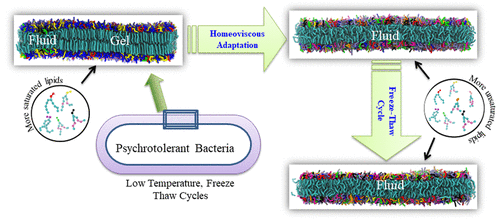当前位置:
X-MOL 学术
›
J. Phys. Chem. Lett.
›
论文详情
Our official English website, www.x-mol.net, welcomes your
feedback! (Note: you will need to create a separate account there.)
Cryostabilization of the Cell Membrane of a Psychrotolerant Bacteria via Homeoviscous Adaptation.
The Journal of Physical Chemistry Letters ( IF 4.8 ) Pub Date : 2020-08-25 , DOI: 10.1021/acs.jpclett.0c01675 Shakkira Erimban 1 , Snehasis Daschakraborty 1
The Journal of Physical Chemistry Letters ( IF 4.8 ) Pub Date : 2020-08-25 , DOI: 10.1021/acs.jpclett.0c01675 Shakkira Erimban 1 , Snehasis Daschakraborty 1
Affiliation

|
Homeoviscous adaptation (maintenance of a critical balance between the saturated and unsaturated lipids) of the cell membrane of psychrotolerant bacteria is essential to protect them against freeze–thaw cycle. But how does the homeoviscous adaptation protect the cell membrane during cold stress? In this Letter, we answer this question using a coarse-grained molecular dynamics simulation technique. On the basis of the reported fatty acid profiles of psychrotolerant bacteria at different temperatures, multiple lipid membranes are simulated at a wide range of temperatures between 250 and 300 K. We explicate how the homeoviscous adaptation minimizes the effect of cold stress on the structure and fluidity of the membrane. Partial freezing of the saturated lipid domain occurs with the self-aggregation of saturated and unsaturated lipids near the melting temperature of the unadapted lipid membrane. The gel-like phase provides necessary local packing density that can be sensed by sensor proteins responsible for the homeoviscous adaptation.
中文翻译:

经由顺势粘性适应使抗精神病细菌的细胞膜冷冻稳定。
耐精神病细菌的细胞膜的稳态粘度适应(维持饱和脂质和不饱和脂质之间的关键平衡)对于保护它们免受冻融循环至关重要。但是,在低温胁迫下,顺势粘性适应如何保护细胞膜?在这封信中,我们使用粗粒度的分子动力学模拟技术回答了这个问题。根据所报道的在不同温度下抗精神病细菌的脂肪酸谱,在250至300 K的较宽温度范围内模拟了多个脂质膜。我们阐述了顺应性适应如何最大程度地降低了冷应力对结构和流动性的影响膜的 饱和脂质结构域的部分冻结发生在饱和脂质膜的融化温度附近,饱和和不饱和脂质的自聚集。凝胶状相提供了必要的局部堆积密度,可以由负责顺势适应的传感器蛋白来感知。
更新日期:2020-09-18
中文翻译:

经由顺势粘性适应使抗精神病细菌的细胞膜冷冻稳定。
耐精神病细菌的细胞膜的稳态粘度适应(维持饱和脂质和不饱和脂质之间的关键平衡)对于保护它们免受冻融循环至关重要。但是,在低温胁迫下,顺势粘性适应如何保护细胞膜?在这封信中,我们使用粗粒度的分子动力学模拟技术回答了这个问题。根据所报道的在不同温度下抗精神病细菌的脂肪酸谱,在250至300 K的较宽温度范围内模拟了多个脂质膜。我们阐述了顺应性适应如何最大程度地降低了冷应力对结构和流动性的影响膜的 饱和脂质结构域的部分冻结发生在饱和脂质膜的融化温度附近,饱和和不饱和脂质的自聚集。凝胶状相提供了必要的局部堆积密度,可以由负责顺势适应的传感器蛋白来感知。





















































 京公网安备 11010802027423号
京公网安备 11010802027423号